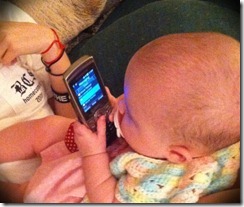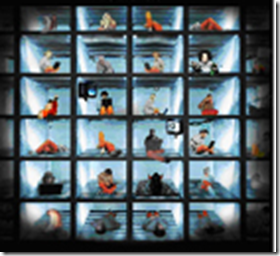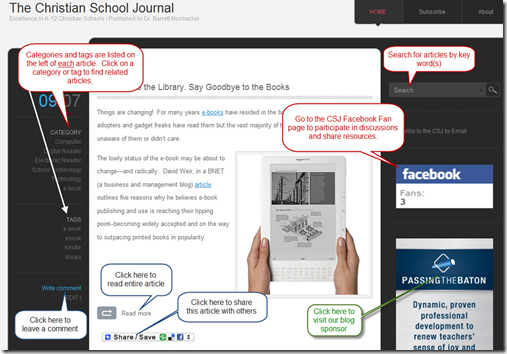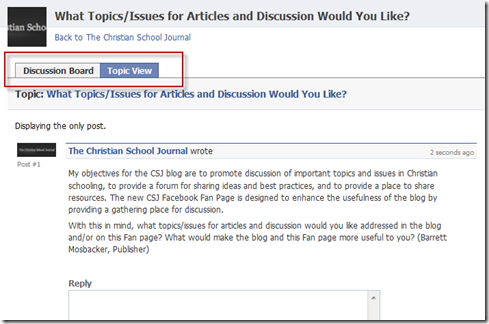![[EMAIL]](http://s.wsj.net/public/resources/images/TE-AA822A_EMAIL_F_20091008202711.jpg)
From the WSJ: OCTOBER 12, 2009
Email has had a good run as king of communications. But its reign is over.
In its place, a new generation of services is starting to take hold—services like Twitter and Facebook and countless others vying for a piece of the new world. And just as email did more than a decade ago, this shift promises to profoundly rewrite the way we communicate—in ways we can only begin to imagine.
We all still use email, of course. But email was better suited to the way we used to use the Internet—logging off and on, checking our messages in bursts. Now, we are always connected, whether we are sitting at a desk or on a mobile phone. The always-on connection, in turn, has created a host of new ways to communicate that are much faster than email, and more fun.
Why wait for a response to an email when you get a quicker answer over instant messaging? Thanks to Facebook, some questions can be answered without asking them. You don't need to ask a friend whether she has left work, if she has updated her public "status" on the site telling the world so. Email, stuck in the era of attachments, seems boring compared to services like Google Wave, currently in test phase, which allows users to share photos by dragging and dropping them from a desktop into a Wave, and to enter comments in near real time.
Little wonder that while email continues to grow, other types of communication services are growing far faster. In August 2009, 276.9 million people used email across the U.S., several European countries, Australia and Brazil, according to Nielsen Co., up 21% from 229.2 million in August 2008. But the number of users on social-networking and other community sites jumped 31% to 301.5 million people.
"The whole idea of this email service isn't really quite as significant anymore when you can have many, many different types of messages and files and when you have this all on the same type of networks," says Alex Bochannek, curator at the Computer History Museum in Mountain View, Calif. So, how will these new tools change the way we communicate? Let's start with the most obvious: They make our interactions that much faster.
Into the River
Years ago, we were frustrated if it took a few days for a letter to arrive. A couple of years ago, we'd complain about a half-hour delay in getting an email. Today, we gripe about it taking an extra few seconds for a text message to go through. In a few months, we may be complaining that our cellphones aren't automatically able to send messages to friends within a certain distance, letting them know we're nearby. (A number of services already do this.)
These new services also make communicating more frequent and informal—more like a blog comment or a throwaway aside, rather than a crafted email sent to one person. No need to spend time writing a long email to your half-dozen closest friends about how your vacation went. Now those friends, if they're interested, can watch it unfold in real time online. Instead of sending a few emails a week to a handful of friends, you can send dozens of messages a day to hundreds of people who know you, or just barely do.
Consider Twitter. The service allows users to send 140-character messages to people who have subscribed to see them, called followers. So instead of sending an email to friends announcing that you just got a new job, you can just tweet it for all the people who have chosen to "follow" you to see. You can create links to particular users in messages by entering @ followed by their user name or send private "direct messages" through the system by typing d and the user name.
Facebook is part of the trend, too. Users post status updates that show up in their friends' "streams." They can also post links to content and comment on it. No in-box required.
Dozens of other companies, from AOL and Yahoo Inc. to start-ups like Yammer Inc., are building products based on the same theme.
David Liu, an executive at AOL, calls it replacing the in-box with "a river that continues to flow as you dip into it."
But the speed and ease of communication cut both ways. While making communication more frequent, they can also make it less personal and intimate. Communicating is becoming so easy that the recipient knows how little time and thought was required of the sender. Yes, your half-dozen closest friends can read your vacation updates. But so can your 500 other "friends." And if you know all these people are reading your updates, you might say a lot less than you would otherwise.
Too Much Information
Another obvious downside to the constant stream: It's a constant stream.
That can make it harder to determine the importance of various messages. When people can more easily fire off all sorts of messages—from updates about their breakfast to questions about the evening's plans—being able to figure out which messages are truly important, or even which warrant a response, can be difficult. Information overload can lead some people to tune out messages altogether.
Such noise makes us even more dependent on technology to help us communicate. Without software to help filter and organize based on factors we deem relevant, we'd drown in the deluge.
Enter filtering. In email land, consumers can often get by with a few folders, if that. But in the land of the stream, some sort of more sophisticated filtering is a must.
On Facebook, you can choose to see updates only from certain people you add to certain lists. Twitter users have adopted the trend of "tagging" their tweets by topic. So people tweeting about a company may follow their tweet with the # symbol and the company name. A number of software programs filter Tweets by these tags, making it easier to follow a topic.
The combination of more public messages and tagging has cool search and discovery implications. In the old days, people shared photos over email. Now, they post them to Flickr and tag them with their location. That means users can, with little effort, search for an area, down to a street corner, and see photos of the place.
Tagging also is creating the potential for new social movements. Instead of trying to organize people over email, protesters can tweet their messages, tag them with the topic and have them discovered by others interested in the cause. Iranians used that technique to galvanize public opinion during their election protests earlier this year. It was a powerful example of what can happen when messages get unleashed.
Who Are You?
Perhaps the biggest change that these email successors bring is more of a public profile for users. In the email world, you are your name followed by a "dot-com." That's it. In the new messaging world, you have a higher profile, packed with data you want to share and possibly some you don't.
Such a public profile has its pluses and minuses. It can draw the people communicating closer, allowing them to exchange not only text but also all sorts of personal information, even facial cues. You know a lot about the person you are talking to, even before you've ever exchanged a single word.
Take, for example, Facebook. Message someone over the site and, depending on your privacy settings, he may be a click away from your photos and your entire profile, including news articles you have shared and pictures of that party you were at last night. The extra details can help you cut to the chase. If you see that I am in London, you don't need to ask me where I am. They can also make communication feel more personal, restoring some of the intimacy that social-network sites—and email, for that matter—have stripped away. If I have posted to the world that I am in a bad mood, you might try to cheer me up, or at least think twice about bothering me.
Email is trying to compete by helping users roll in more signals about themselves. Yahoo and Google Inc. have launched new profile services that connect to mail accounts. That means just by clicking on a contact, one can see whatever information she has chosen to share through her profile, from her hobbies to her high school.
But a dump of personal data can also turn off the people you are trying to communicate with. If I really just want to know what time the meeting is, I may not care that you have updated your status message to point people to photos of your kids.
Having your identity pegged to communication creates more data to manage and some blurry lines. What's fine for one sort of recipient to know about you may not be acceptable for another. While our growing digital footprints have made it easier for anyone to find personal information about anyone online if they go search for it, new communications tools are marrying that trail of information with the message, making it easier than ever for the recipient to uncover more details.
A Question of Time
Meanwhile, one more big question remains: Will the new services save time, or eat up even more of it?
Many of the companies pitching the services insist they will free up people.
Jeff Teper, vice president of Microsoft Corp.'s SharePoint division, which makes software that businesses use to collaborate, says in the past, employees received an email every time the status changed on a project they were working on, which led to hundreds of unnecessary emails a day. Now, thanks to SharePoint and other software that allows companies to direct those updates to flow through centralized sites that employees can check when they need to, those unnecessary emails are out of users' in-boxes.
People were very dependent on email. They overused it," he says. "Now, people can use the right tool for the right task.
Perhaps. But there's another way to think about all this. You can argue that because we have more ways to send more messages, we spend more time doing it. That may make us more productive, but it may not. We get lured into wasting time, telling our bosses we are looking into something, instead of just doing it, for example. And we will no doubt waste time communicating stuff that isn't meaningful, maybe at the expense of more meaningful communication. Such as, say, talking to somebody in person.





 There are many who doubt or downplay the relevance of the Old Testament to our times. Those people have probably never taken the time to read the book of Proverbs. I read from Proverbs almost every day and I am continually amazed at just how relevant this book is. It seems that wisdom is timeless. The lessons David taught Solomon speak to myself and my children as much as they did to the men and women of ancient Israel. The wisdom of God given to Solomon continues to ring loud and clear in my heart.
There are many who doubt or downplay the relevance of the Old Testament to our times. Those people have probably never taken the time to read the book of Proverbs. I read from Proverbs almost every day and I am continually amazed at just how relevant this book is. It seems that wisdom is timeless. The lessons David taught Solomon speak to myself and my children as much as they did to the men and women of ancient Israel. The wisdom of God given to Solomon continues to ring loud and clear in my heart.
 Dr. Barrett Mosbacker, PublisherFacebook recently irked me. I am a Facebook user but I am not a heavy user. I keep up with a few colleagues and friends but mostly I post articles on Facebook that I believe others may find interesting. I mostly use Facebook so that I can work through the biblical, educational, and social implications of social technologies as a Christian. We are called to bring all of life under the Lordship of Christ—that includes Facebook and similar technologies.
Dr. Barrett Mosbacker, PublisherFacebook recently irked me. I am a Facebook user but I am not a heavy user. I keep up with a few colleagues and friends but mostly I post articles on Facebook that I believe others may find interesting. I mostly use Facebook so that I can work through the biblical, educational, and social implications of social technologies as a Christian. We are called to bring all of life under the Lordship of Christ—that includes Facebook and similar technologies.  moments to the Web for all to see. It’s easy to say that privacy is dead, we all live in public now, and just deal with it.
moments to the Web for all to see. It’s easy to say that privacy is dead, we all live in public now, and just deal with it.




![[EMAIL]](http://s.wsj.net/public/resources/images/TE-AA822A_EMAIL_F_20091008202711.jpg)